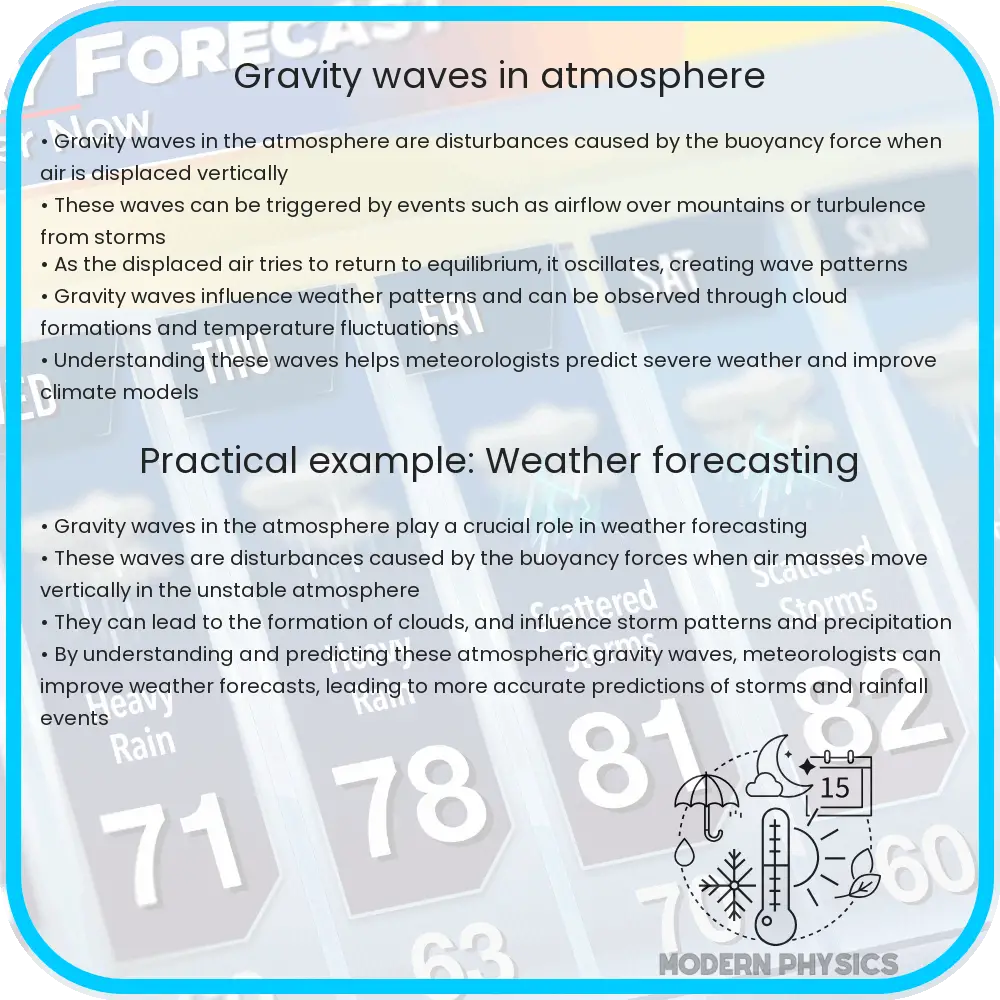Gravity waves are atmospheric oscillations driven by the restoring force of gravity, fundamental to understanding weather systems and atmospheric dynamics.

Exploring Gravity Waves: The Fascinating Forces in Our Atmosphere
Gravity waves, not to be confused with gravitational waves in astrophysics, are a phenomenal atmospheric occurrence that helps to transfer momentum and energy between Earth’s different atmospheric layers. They play a crucial role in our weather systems and our understanding of atmospheric dynamics. This article aims to elucidate the mysterious physics behind gravity waves and their impact on our planet.
What are Gravity Waves?
At a fundamental level, gravity waves are oscillations that occur due to the restoring force of gravity acting to rebalance a displaced air parcel. Imagine tossing a stone into a pond; the ripples that propagate across the water’s surface are similar in nature to gravity waves in the atmosphere. However, instead of water, these waves occur within the fluid layers of gases in the atmosphere.
Gravity waves should not be mistaken for gravitational waves, which are ripples in spacetime caused by some of the most violent and energetic processes in the Universe. Atmospheric gravity waves are fluid oscillations resulting from the equilibrium displacement within the Earth’s atmosphere, stabilized by the gravitational pull of the Earth.
How Are Gravity Waves Generated?
Several mechanisms can trigger the generation of gravity waves in the atmosphere:
- Topographic Forcing: When air flows over mountain ranges or large terrain features, it can be lifted and then dropped down the other side, initiating wave motions as it seeks to return to its original equilibrium state.
- Weather Fronts: The strong convective activity at cold or warm fronts can force air parcels to displace upwards or downwards, leading again to the formation of wave patterns as the air mass tries to stabilize.
- Storm Systems: The powerful updrafts and downdrafts within storm systems such as thunderstorms or hurricanes can also produce significant gravity waves.
The Physics Behind Gravity Waves
The mathematical description of gravity waves is fascinating and involves several variable factors. They can be modeled by considering the atmosphere as a stably stratified fluid under gravity. When this fluid’s equilibrium is disturbed, it oscillates and gravity acts as the restoring force.
To better understand, we use the basic wave equation derived from fluid dynamics and atmospheric science equations. Given an air parcel’s displacement in a stable atmosphere, the force that works to restore it back to equilibrium is gravity. The general form of the wave equation for gravity waves can be written as:
v2 = (N2 * sin2(θ)) / (ω2 – f2)
Here v is the phase speed of the wave, N is the Brunt-Väisälä frequency (which quantifies the stability of the atmospheric stratification), θ is the wave’s angle of propagation relative to the horizontal, ω is the frequency of oscillation, and f is the Coriolis parameter, related to the rotation of the Earth.
This equation helps us to predict the behavior of gravity waves under various atmospheric conditions and contributes significantly to our understanding of meteorological patterns.
Impact of Gravity Waves on Weather and Climate
Gravity waves have profound effects on the Earth’s atmosphere and weather systems. They are essential in transporting momentum and energy between the atmospheric layers and contribute to mixing processes that affect weather development and climate variability. For example, they can influence the development of cyclones and modulate jet streams, which are critical factors in weather systems across the globe.
Further, researchers have observed that gravity waves can also impact the distribution of chemical constituents in the upper atmosphere by enhancing mixing between the troposphere and the stratosphere. This has crucial implications for understanding ozone dynamics and other vital atmospheric processes.
Observational Techniques and Recent Studies
To study gravity waves, scientists use a variety of observational techniques, ranging from satellite imagery to radar and lidar systems. These tools help in capturing the wave patterns and dynamics occurring in the upper and lower layers of the atmosphere. Advances in technology have significantly enhanced our ability to detect and analyze these atmospheric phenomena.
Recent studies focus on the role of gravity waves in climate models. Improved understanding and simulation of these waves contribute substantially to the accuracy of weather forecasting and climate predictions. This ongoing research is vital, as integrating atmospheric wave dynamics into models helps in addressing challenges related to global warming and weather variability.
Challenges in Understanding Gravity Waves
Despite the progress, several challenges remain in the study of gravity waves. One major issue is the high complexity and variability of the atmosphere which makes it difficult to model gravity wave generation and propagation accurately. Additionally, the indirect nature of observing these waves requires sophisticated data interpretation and advanced computational models.
Researchers are continually working to develop better models and more precise instruments to overcome these challenges, aiming to deepen our understanding of how gravity waves affect atmospheric dynamics on both local and global scales.
Conclusion
Gravity waves are not just fascinating atmospheric phenomena but are also fundamental to our understanding of weather and climate dynamics. Through the continuous efforts of meteorologists and atmospheric scientists, we are gradually peeling back the layers of complexity to reveal the intricate ways in which these waves shape our environment. As technology and research methodologies advance, our grasp of gravity wave impacts will only improve, paving the way for enhanced weather forecasting and climate prediction. This greater understanding underscores the importance of scientific research in providing insights that are critical to tackling environmental challenges and safeguarding our planet for future generations.
